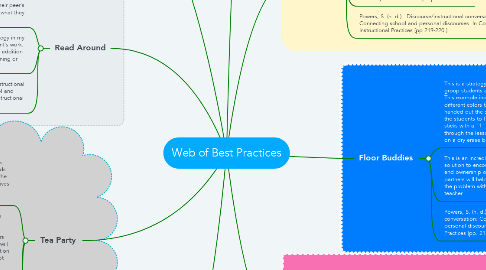Web of Best Practices
by Lydia Renfro


1. Student Talk
1.1. Giving the students a chance to talk and to express their thoughts and ideas in an authentic way will build their knowledge.
1.2. Having circle time in the morning to give the students the chance to share and discuss events in and out of school will give the students ownership.
1.3. After reading the research on data of teacher vs. student talk during the school day, I am very interested in switching my role as the class director to more of a passive role when it comes to discussions and conversation during class. Reflecting back on my classes, I have been teaching with direct teaching rather than letting the students have a chance to really delve deep into topics. I believe that all of the practices on this page will help me to become more of a joint-learner rather than just asking my students to retain what I teach them.
1.4. Powers, S. (n. d.). Discourse/instructional conversation: Connecting school and personal discourses. In Core Instructional Practices (pp. 208 ).
2. Read Around
2.1. Students can share their writing while sitting in a circle. I am very interested in the fact that students can listen closely to their peer's writing and hear "what works" and what they could use help on.
2.2. I would enjoy utilizing this strategy in my classroom to share each student's work. This would possibly be a great addition to circle time, either in the morning or the afternoon.
2.3. Powers, S. (n. d.). Discourse/instructional conversation: Connecting school and personal discourses. In Core Instructional Practices (pp. 212).
3. Tea Party
3.1. An interesting way to introduce characters from a text. The teacher will pass out cards with each character's point of view from the story or a passage from the story. This gives the students an in-depth look into a character's motivation and perspective.
3.2. This would be a wonderful way to begin discussing a story in both fiction and non-fiction texts. Giving the students background knowledge on the characters that are involved in the upcoming story will give the students the necessary information to understand the characters. I would not use this each time, however, if a higher complexity level text was being discussed, this would be a great strategy.
3.3. Powers, S. (n. d.). Discourse/instructional conversation: Connecting school and personal discourses. In Core Instructional Practices (pp. 210).
4. Musical Shares
4.1. This sharing technique is essentially the game "musical chairs" with review material or sharing of work. The teacher will play music and the students will walk around the classroom. When the music stops, the students will find the person nearest them to share their material with or to work with. The teacher will need to lay down some ground rules.
4.2. This would be an entertaining way to group the students at random while making sure that they are not paired with their typical groups.
4.3. Powers, S. (n. d.). Discourse/instructional conversation: Connecting school and personal discourses. In Core Instructional Practices (pp.216).
5. Instructional Conversations
5.1. Conversations that are engaging, interesting, relevant to students, and easy to understand and follow.
5.2. Conversational uptakes: respectful comments that allow students who may not have the sufficient English level to answer or express their ideas.
5.2.1. It was eye opening to read Power's view on conversations and discussions in the classroom. It caused me to reflect on my practices in my classroom. I would like to try to have more instructional conversations and discussions.

